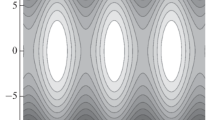Abstract
A model for describing the vertically averaged vortex motions of an incompressible viscous fluid with an arbitrary vertical structure of the bottom Ekman boundary layer is proposed. An approach similar to that adopted in [1] is used: the second moments of the deviations from the average velocities required in order to close the vorticity equation are calculated by means of the Ekman solution for gradient flows, which makes it possible to take the integral bottom boundary layer effect into account. As a result, these terms lead to a specific form of nonlinear friction with a coefficient that depends on the vorticity of the average flow. In the particular case of a constant vertical turbulent transfer coefficient the inaccuracies of the model described in [1] can be eliminated. The generalized vorticity equation obtained has solutions of the vorticity spot type with a uniform internal vorticity distribution, which can be effectively investigated by means of appropriate algorithms [2]. The mechanism of entrainment at the vorticity front is illustrated with reference to the example of the evolution of vorticity spots. An exact solution of the problem of the evolution of an elliptic vortex (generalized Kirchhoff vortex), which in the case of fairly strong anticyclonic vorticity degenerates first into a line segment (vortex sheet) and then into a point vortex, is constructed. Equations describing the dynamics of an elliptic vorticity spot in an external field with a linear dependence of the velocity on the horizontal coordinates and generalizing the classical Chaplygin-Kida model [3, 4] are constructed.
Similar content being viewed by others
References
S. N. Aristov and P. G. Frik, “Nonlinear effects of the influence of the Ekman layer on the dynamics of large-scale vortices in shallow water,”Zh. Prikl. Mekh. Tekh. Fiz., No. 2, 49 (1991).
N. J. Zabusky, M. H. Hughes, and K. V. Roberts, “Contour dynamics for the Euler equations in two dimensions,”J. Comput. Phys.,30, 96 (1979).
S. A. Chaplygin, “A pulsating cylindrical vortex,” in:Collected Works, Vol. 2 [in Russian], Gostekhizdat, Moscow (1948), p. 138.
S. Kida, “Motion of an elliptic vortex in a uniform shear flow,”J. Phys. Soc. Jpn.,50, 3517 (1981).
G. Kirchhoff,Vorlesungen über mathematische Physik, Mechanik, Leipzig (1883).
A. E. H. Low, “On the stability of certain vortex motions,”Proc. London Math. Soc.,25, 18 (1894).
M. V. Hezlin and E. N. Snezhkin,Rossby Vortices and Spiral Structures [in Russian], Nauka, Moscow (1990).
M. V. Melander, N. J. Zabisky, and A. S. Styczek, “A moment model for vortex interactions of two-dimensional Euler equations. Pt. 1. Computational validation of a Hamilton elliptical representation,”J. Fluid Mech.,167, 95 (1986).
Author information
Authors and Affiliations
Additional information
Translated from Izvestiya Rossiiskoi Akademii Nauk, Mekhanika Zhidkosti i Gaza, No.6, pp. 49–56, November–December, 1992.
Rights and permissions
About this article
Cite this article
Kozlov, V.F. Model of two-dimensional vortex motion with an entrainment mechanism. Fluid Dyn 27, 793–798 (1992). https://doi.org/10.1007/BF01051355
Received:
Issue Date:
DOI: https://doi.org/10.1007/BF01051355




